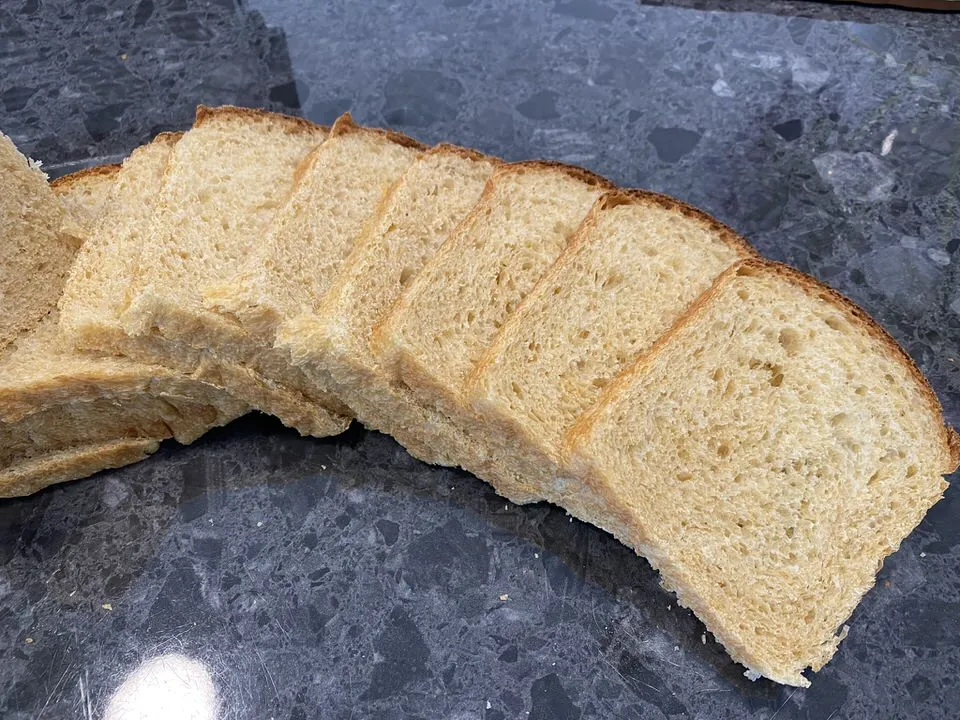
Background
My first attempts at this bread were flawed in that I got very little rise. Debra Wink (DW) contacted me and suggested some tweaks. As a result, I introduced some Vital Wheat Gluten (VWG) to increase the protein percent of my whole-wheat flour. I also pre-fermented 5 percent of the flour in a stiff levain. I wasn’t sure what effect the levain would have; rise, flavour enhancement, crumb or all. I’ve had a great result by incorporating both the VWG and the levain now for many weeks.
Today’s Experiment
I wanted to check what effect the levain was having on the rise, crumb, and flavour of the baked loaf. Today’s bake: I eliminated the levain and recalculated the formula.
Result
I compared the rise, crumb, and taste of both loaves (my lovely wife was also a judge).
Rise: at all stages throughout the process, the rise hit the milestones. Picture 1 is at the start of the final proof. Picture 2 is at the end of final proof after 3 hours at 22C/71F. I concluded that the levain did not enhance the rise in speed or volume over time. The baked loaf had a good oven spring and baked with a nice golden colour. Pic 3.
Crumb: The crumb of both loaves was identical. I put this down to the low per-cent of pre-fermented flour. DW advised that 4-5% would not have a detrimental affect of the crumb. Both were soft as a sandwich loaf should be. Pic 4.
Taste: This was the only discernible difference. The loaf with the levain had an enhanced flavour. The loaf baked without the levain was very nice but lacked the flavour of the levain loaf.
Conclusion
I will continue to include the 5% PFF in the formula.
Cheers,
Gavin
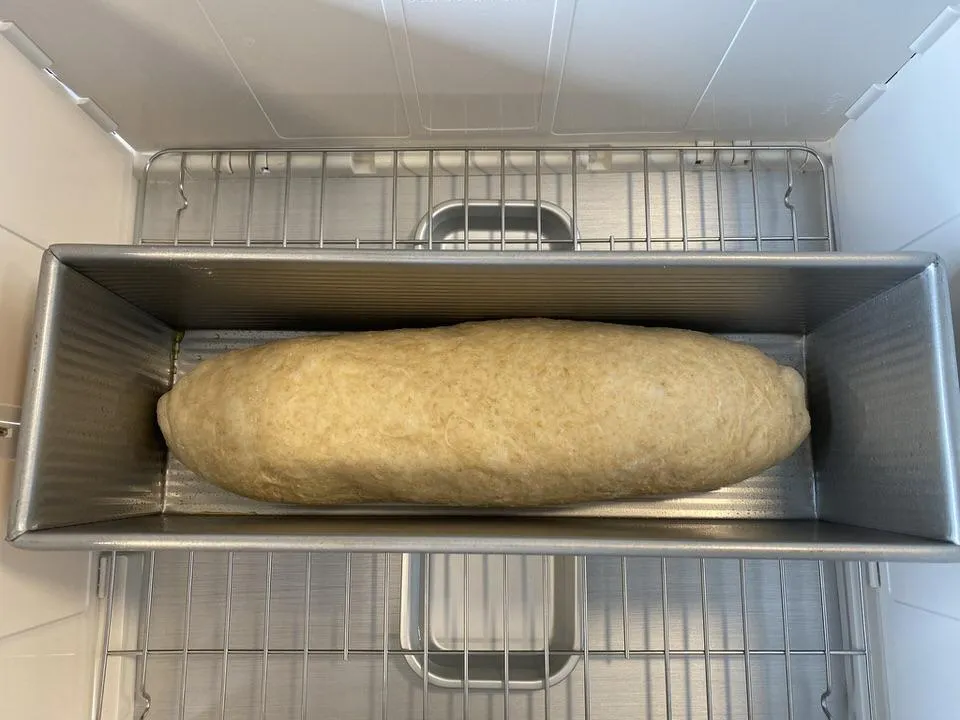
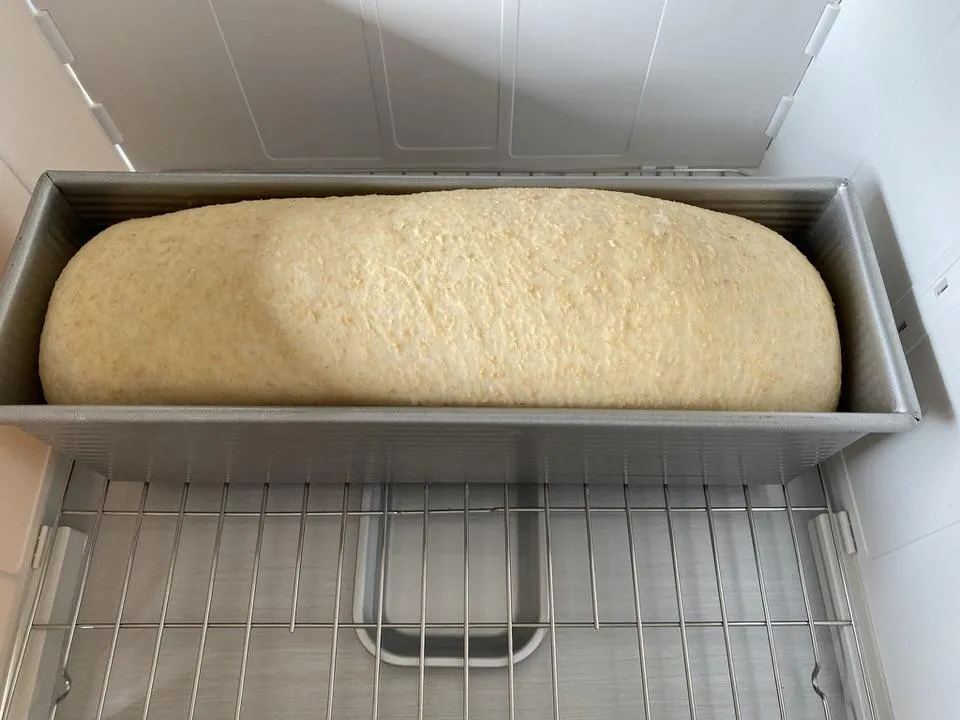
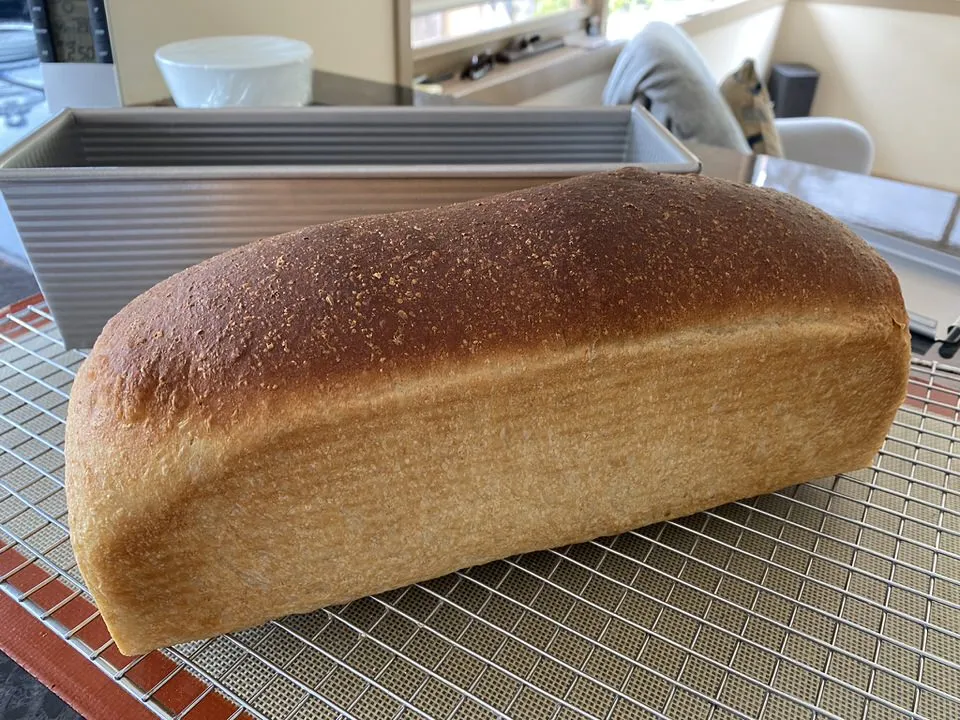
- gavinc's Blog
- Log in or register to post comments
Did you use a 5% stiff levain in addition to a percentage of starter? It is not clear if the 5% stiff levain is an extra or as part of the starter. The coloration of the bread looks very light for being a 100% WW, it looks great though. Thanks.
Hi Ming. The starter is not counted a part of the levain. You adjust the amount of starter depending on the time and temperature to mature. Here is the formula table:
Image
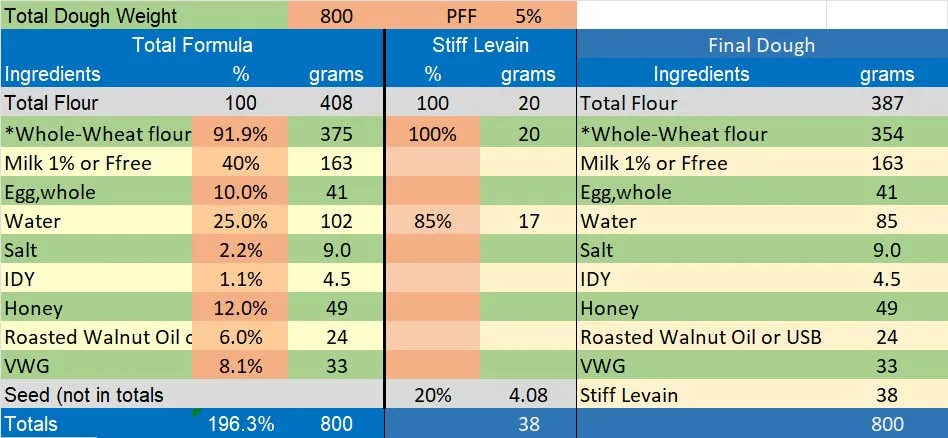
Great, thanks for the info. Wow, I did not realize there are many other ingredients that go into this bread. This is the type of bread I would like to make next after I am tired of my baguette making.
Let me know when you are ready to try it out and I can give you the instructions.. The process is quite unique to this bread. Also the amount of VWG is calculated on the protein level of your Whole-Wheat flour.
Cheers,
Gavin
Great Gavin, I will definitely reach out when I need more info about making this bread. Cheers!
For some reason, when I hear of the word levain, I associate it with a sourdough, duh, it could just be with commercial yeast. I actually make a 95% preferment "levain" (45% hydration biga) with a small amount of instant yeast for my baguettes weekly and I have never thought of it as a levain in this context. Anyhow, thanks for the enlightenment and sharing the recipe of this fine bread.
Hi Ming. I'm a bit confused. I only refer to a levain in the context of sourdough, otherwise I attribute the commercial yeast preferments by their type, eg biga, poolish or pate-fermentee. If you have any other questions, happy to help out.
Haha Gavin, sorry for the confusion, I had too much to drink last night and wasn't thinking straight.
Ha ha. Been there, done that!
Nice experiment Gavin. It’s amazing what even a small amount of levain can have on the flavor even when there is no discernible effect on fermentation to the naked eye. Your 100% WW loaves always look so good.
Benny
Thanks Benny. Yes the reason for the experiment was to see if I could eliminate the levain which wasn't part if the original formula. But I am now convinced to keep it in for the flavour it imparts.
Gavin
The amount of rise during the proof is impressive. Is your wheat a white wheat? I am going to try adding an egg to my next whole wheat loaf and reconsider VWG.
Don
Hi Don. Thanks. I use white wheat as I don't have access to any red wheat. dw prefers red wheat for flavour and it has a higher protein percent (VWG is not needed). I love this bread and has become a regular addition to our bread basket.
Gavin
Hi Gavin, just wanted to show you how nice this dough works for hamburger buns too. I made one 9x4x4 loaf yesterday and then these buns, scaled at 2 1/4 oz., with the rest of the dough. I used butter in this dough because I like that for buns and rolls.
If you can get your hands on some red wheat, you'll get more flavor out of the dough. Also, you might bake lower in the oven to get some good browning on the bottom and sides. Deep crust color is important for flavor. I bake pan loaves on the bottom shelf in my oven with convection fan on at 350F. (375F fan off, center shelf for buns.)
To give some background and credit, the addition of a small amount of sourdough is something I picked up from Jeff Yankellow (one of the developers of the approachable loaf). It's not in Bread because I was just starting to experiment with it at the time (this was more than two years ago now), and because Jeffrey H. requested a formula for the straight dough chapter. If you don't have starter convenient and ready to go, it's nice enough without.
Jeff Yankellow has some great formulas for 100% whole wheat enriched things like croissants and sweet dough, and I noticed a common use of 4% prefermented flour as sourdough (100% hydration) in these otherwise yeasted doughs. Not a pinch of yeast to enhance leavening, but basically a "pinch" of sourdough to enhance flavor. It had never really occurred to me to use it that way, but what a great idea! I think you've been playing with it more than I have, Gavin --- keep up the good work! :)
dw
Hi Debbie,
Thanks for your comments. I love the idea of using this dough to make buns. I sometimes make brioche buns, but I’ve become so used to making this ww bread that I would feel very comfortable with using it for the buns. I love the shape you obtained in your picture.
I’m going to search for some red wheat to get that extra flavour punch. I think it would also enhance the colour as my bread looks paler in comparison to yours. I may even be able to eliminate the VWG.
Thanks for keeping contact and showing interest as I’m sure there will be a few TFL’ers give this a try. Once again, I’m indebted to your encouragement, ongoing tips and advice.
Cheers,
Gavin.
UPDATE: I can't buy red wheat in Australia. White wheat dominates and is apparently driven by customer preference here and overseas.
For these I used the hamburger bun/mini tart pan (on the right) because I only had 6 to make. The muffin top pan on the left works great too even if not as deep. When I do a whole batch of 12 buns I scale them at 2.5 oz and put them all on one jelly roll pan (10.5" x 15.5" x 1"). They will rise into one another like the packaged pull-apart buns you get at the store (at least we do here in the US). I know I had a good photo somewhere, but I can't seem to find it.
The way I form them is pre-shape round into nice tight mini-boules. Let them rest until relaxed, about 20-40 minutes. Then flatten them to a width that comes to within 1/4" of the side walls of the wells, or about 3". The wells are 3.5" at the bottom and a little over 4" at the top, so it gives them a nice base. But they can also be done free-form on a sheet pan.
It's all good, and that's the beauty of bread :)
dw
Thanks Debbie. Very useful tips again. I know what you mean about pull-apart buns as we have them here also. We have some muffin pans and I never thought to use them for buns. When I've made brioche hamburger pans, I made foil rings held together with a couple of staples. They are a bit more work than using muffin pans, so you have my attention. Worked better than I thought. I've attached some pic of them.
Gavin.
Is it necessary to use rings or forms for burger buns at all? When I’ve done them they’ve always been freeform.
Image
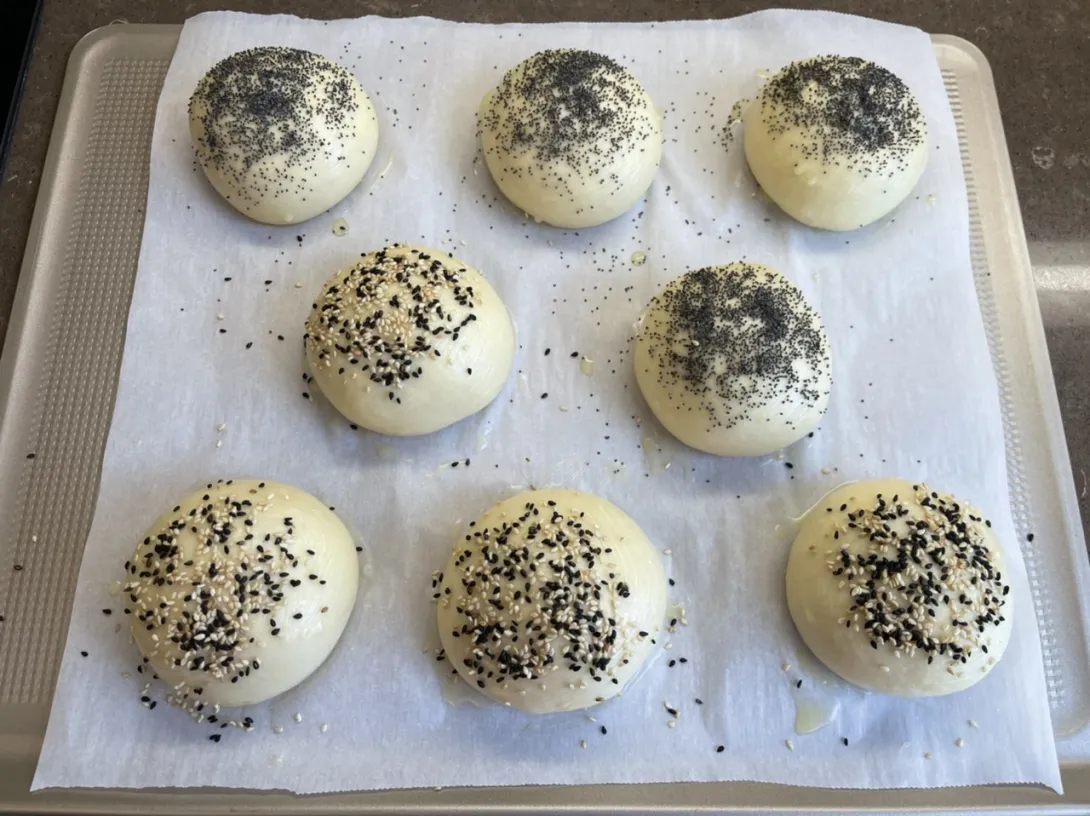
Image
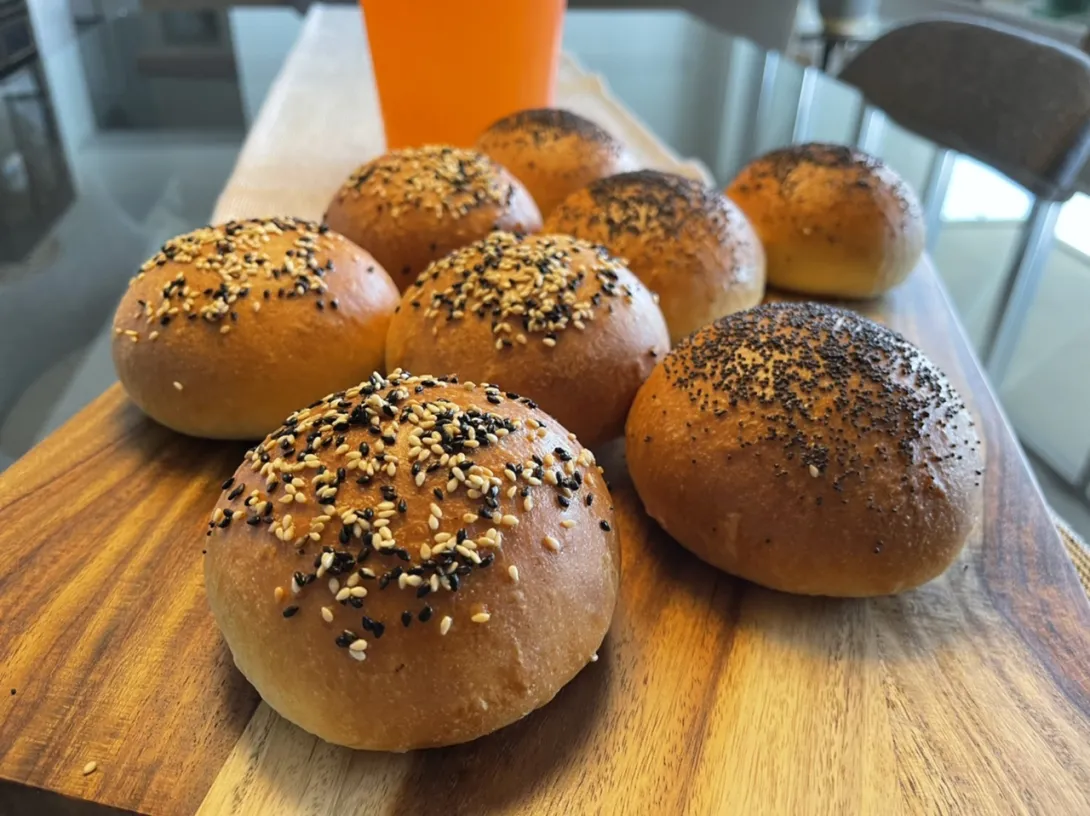
No, not necessary at all. There are many different approaches. Just depends on convenience and desired presentation. Those buns look great and appealing.
We used to make a flat burger bun where a second baking tray was inverted and placed over the bottom tray that kept the resulting buns to that flat shape they were very popular , the steel baking sheets were quite heavy so didnt get pushed up we called them lidded flats.
Derek
Derek, this sounds like my kind of thing; I'm always looking for ways to reduce the bread in the buns while still ending up with something wide enough to cover the burger. Did you bake them that way, or take the "lid" off after proofing?
Sorry for the delay only just picked up this extended posting.
Yes Deb we baked them with the tray staying on top of the buns.
My cousin Ray has just had some black steel trays folded up so that he can recreate these buns that you no longer see in the shops. i met the guy that folded them up for him and he is totally blind and has a fantastic home workshop. I was blown away with all his equipment and engineering skills. I did have to laugh when he said i suppose i will have to turn the lights on for you guys. i am going to see if i can borrow Rays new sheets and show them here! The beauty of getting a metal shop to fold some up is you can get them to fit your oven and determine the depth of the sides being folded up. you only need the folds on three sides and that allows for the rolls to be easily slid straight off the end and also steam to escape during the bake.
i am looking for someone to fold up some full size bakers sheets for a friend that has just acquired a commercial size oven. Of course if a shop is going to fold them up its best to get a whole steel sheet cut and folded because a big part of the cost is setting up the guillotine and the folder.
Amazing that the guy who made them is blind. I look forward to seeing these pans, if your cousin is willing to share :)
Dough pieces scaled @ 2.5 oz. and proofed/baked on 10.5 x 15.5" jelly roll pan.
Changes to basic formula this time: 10% yolks instead of whole eggs and 10% butter instead of 6% roasted walnut oil, 2% salt/1% yeast. It needed 30% water.
Altogether: 100% flour, 40% low-fat milk, 30% water, 10% yolks, 2% salt, 1% ADY, 12% honey, 10% butter. 205% in total.
Pre-Shape
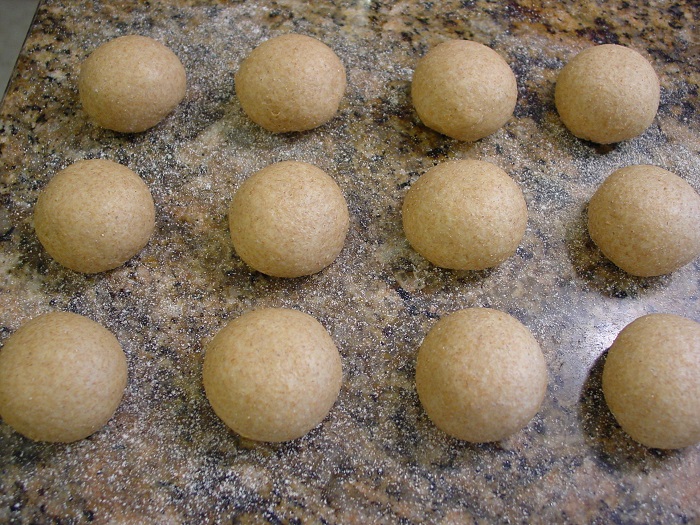
Final Shape (flattened after about 45-minute rest)
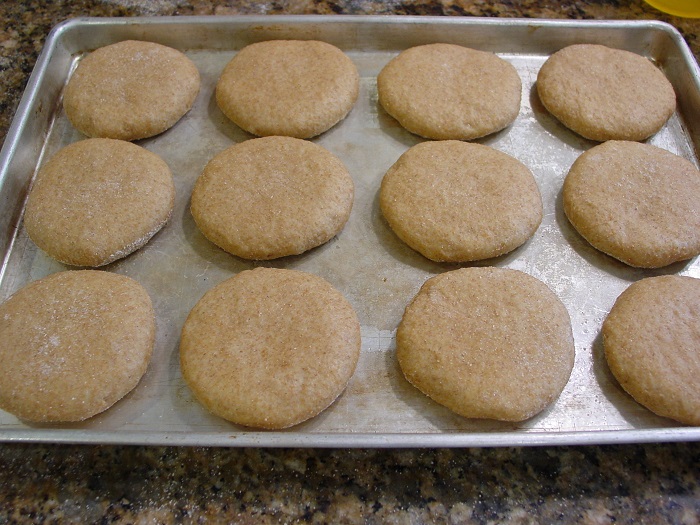
Proofed
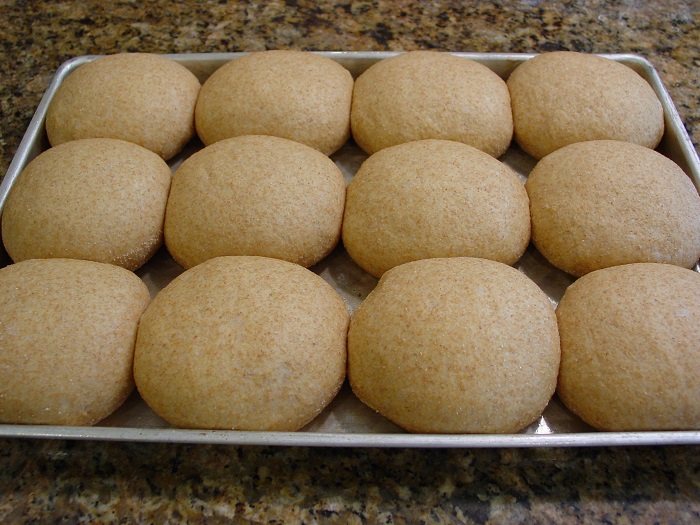
Baked
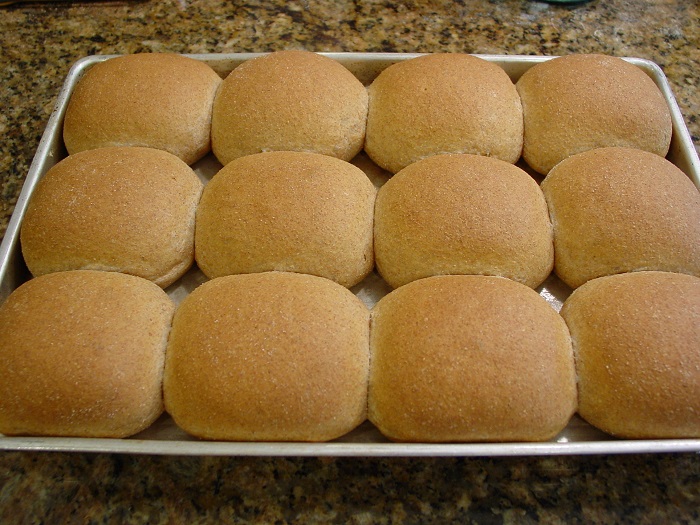
Split
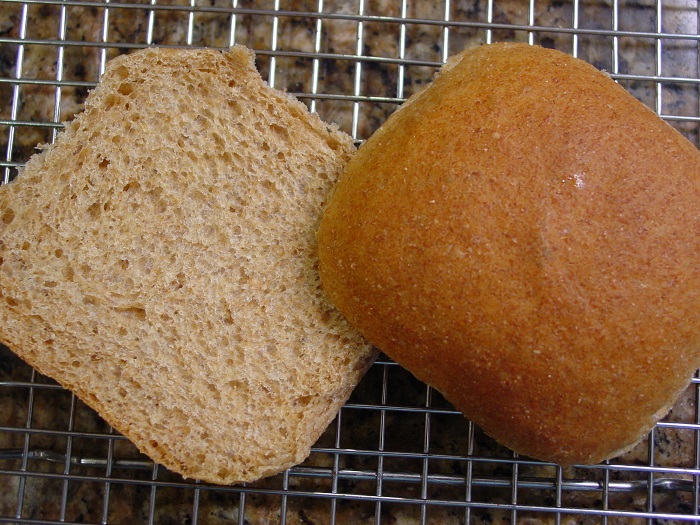
Crumb Detail
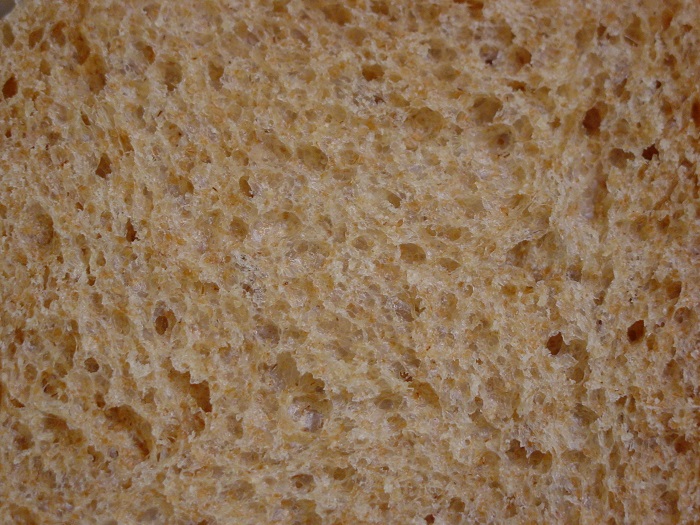
Wow! They look fabulous. I must try these soon. I hope your memorial day holiday went well.
We had nice buns for our burgers --- and everything else too :)
Hi Gavin i have seen a multitude of different coloured wheats at the Royal show which have often been used in displays for the different regions and their produce, might be worth looking out for especially when the show season kicks off soon, worth a chat to some of the producers at the displays
from Department of Industries and Regional Development
Wheat quality
Western Australia produces white grained wheat varieties that generate a bright white flour and high flour milling yield. WA wheat typically has low moisture content, low discolouration and high bulk density and is suitable for a range of products including different breads. WA's dry harvesting environment results in low moisture content and low risk of weather damaged grain.
Major wheat milling grades in WA are:
VWG my pet hate, for me its wheat gluten. The addition of Vital seems to have taken root especially in the US. and although gluten is an essential element of flour for yeast raised breads. adding more gluten is just that adding gluten either in the powdered form or the wet form. calling it VWG or Vital Wheat Gluten can be quite misleading i feel It's almost like all the ingredients should be allocated adjectives i can almost see a dough formula calling for irreplaceable bread flour,magical compressed yeast, life giving water,
Kind regards Derek
Thanks Derek. I hope this year we can get to our Royal Show without the fear of COVID. There are not many growers here that produce red wheat like the US. While I don't hate the term "VWG" I did find it confusing at first as we have a brand called "Vital" that produces a range of diet nutrients etc. The wheat gluten I buy is simply called "Gluten Flour" by Lotus brand. It's wheat and is 75% protein. Works a treat and helped me tremendously. I used a Pearson's Square to calculate the required amount.
I hope you are keeping safe and well.
Cheers,
Gavin.
Nothing wrong with the substance and has its use in strengthening weak flours, In the bakery We used to get it in the form of wet gluten, it was the by product of a company that was producing starch for Japanese paper manufacturing.
i am hoping to contact Ray Harrington the guy in Jon j message to you as his farm is about 150klm away and its not to far out of the way when going to the vineyard in the Great Southern district.
regards Derek
Thanks Derek. I'm keen to know how you go with your discussion with Ray Harrington. It would be great to find out how to get our hands on his grain.
Cheers,
Gavin
Hi Gavin hot off the press i have just been speaking to Tim and Ray Harrington regarding Red wheat and have been told i can come by and fill some bags of the stuff, two main varieties, Spring and Winter they seem quite keen for us to have a go at milling some flour and test baking. i am meeting with another Member of Freo Food Bread who is also a progressive bakery owner and he is quite keen too and has the mill that we will use. He would also have the capacity to take the whole thing a lot further too. there is a whole lot of interest in where our food is actually grown these days too. I have just now received a message from Tim regarding Lupin flour and the need to get that into the diet more. Ray is also pioneering Flax growing here in the West too.
I am so looking forward to meeting these guys in the next week or so. i shall have to get some good bags ready for the trip south.i think i will be making it a special trip as i can see its going to be great day.
Regards Derek
Nice work Derek. I'd be keen to get my hands on some red wheat berries for testing. Let me know if this is possible.
Regards,
Gavin.
I'll be following your saga and hoping these red wheat options are good for breadmaking :)
My best,
dw
Hi Deb things progressing nicely Early this morning (6am) i met Lachie the owner of Big Loaf here in the west and the guy that has a small flourmill and is passionate about local produce and quality bread, We are hoping to visit Tim the farmer next Saturday if that suits him,i suggested to Lachie that we take some of his great breads with us as they dont get anything like that in their remote location. Just waiting to see if its good for next week. ps i got to the bakery early and enjoyed speaking with a young lady Emily who has recently finished her Bakers apprenticeship. she was busy running three spiral mixers.
regards Derek
Hi Debbie,
I've been going over your comments to refresh my understanding of your advice. I picked up on Jeff Yankellow's comment to use 4% prefermented flour as sourdough (100% hydration). I've adjusted my spreadsheet for the next bake. Cheers.
Sorry Gavin, I didn't mean you needed to change to 4% in liquid starter, only that his small percent was where it started for me. If you prefer liquid starter, that's fine, but beware that it will bring more proteolytic activity than a firm starter and so you should use or increase it cautiously. You can probably use more firm sourdough if more sourdough is what you want to do. Make sense? Always let your own taste be your guide :)
My best,
dw
Thanks Debbie. I'll revert back immediately :) I'm getting very good results in flavour with the 5% PFF @ 85% hydration. I've got one in final proof now ready for the oven in about 10 minutes.
Cheers,
Gavin
Hi Gavin
Lovely bake and lots of food for thought. My son would absolutely love this bread for his school sandwiches.
I was looking through the list of ingredients - walnut oil, does that bring any flavour to the bread or do you think another oil like olive could be used in its place?
-Jon
Edit: Out of curiosity I did a google and found that there are farmers growing red wheat, like this guy on the Perth end of the country - https://www.farmweekly.com.au/story/7503326/red-wheat-proves-its-worth-against-frost/ - I wonder who he is selling his wheat to?
Hi Jon,
It's great for sandwiches, nice and soft with lots of flavour. The recipe calls for roasted walnut oil or you can substitute with unsalted butter. I can't buy roasted walnut oil, so I've been using cold pressed walnut oil that is easily available here. I like the flavour and it does impart a nice taste in the bread. I haven't tried using unsalted butter so far, but intend to when making hamburger buns as Debra suggests. Regarding the use of other oils; I can't see why not, just try and see.
Thanks for the tip on the red wheat, I shall look into it.
Cheers,
Gavin.
Hi Jon j that was a great article you found im in Western Australia and that little community is on the way down to my cousins vineyard. I think i shall see if i can make contact and perhaps see if i can aquire some wheat berries i know of a couple of people that have mills too. ,
Frost can be a problem for Wheat Farmers and was again this year where a bumper harvest was on the cards. My cousin had two nights with a touch from JACK in the vineyard 2019 the frost happened just after the vines had flowered and the berries were forming, all went black and dropped off. disastrous year no fruit but still having to look after the vines, it also affected them for the following vintage but looking good for this year.
Derek
Hi Derek,
Please keep us posted if you manage to get hold of the farmer and some wheat berries! Curious to know the outcome.
-Jon
Hi Jon I have made contact with the Bunge who are the grain company in the story and sent an email outlining our interest in the red wheat for bread making purposes and hope to hear back soon i will keep you up dated as things progress.
And me pls :) When I read it, Bunge are a world wide grain distributer. I hope they can point us to a supplier.
While I’m not on a 100% WW quest, I have gone through Benny’s recipes, yours and many out there just to find out why it’s so hard to lift these kinda loaves especially if I want to use only atta whole wheat in the recipe. Just before Christmas I tested out a tiny loaf without any preferment and ended up with a dense little loaf. While it tasted good (there’s something about atta that I like), if wasn’t airy enough. That little loaf was turned into surprisingly tasty breadcrumbs and herbed croutons.
Thank you Gavin (Benny and all you experts here) for sharing so much knowledge and guidelines from your continuous experimentations into such recipes. ☺️ I’ll have to test a little bit more with the flours I have as well.
- Christi
Hi Christi,
I've found that the key is the percent protein of the flour. I had trouble when first trying Debra Winks 100% whole-wheat sandwich bread due to my whole-wheat flour being only 10.8% protein. Debra is now using red winter wheat that is 16-17%. My solution was to add some VWG in the correct amount to lift my flour's protein to 16%. Success! I suggest that you check what the Atta flour is and make the adjustment.
Gavin.
Just to clarify, I made this bread for many years with KA Traditional Whole Wheat flour which was 14% protein hard red winter wheat and have always gotten fine sandwich bread from it. So I can say that 14% is enough if it's good quality gluten-forming protein. The flour I'm using now is an organic hard red wheat flour from War Eagle Mill in Arkansas. It must be spring wheat because it is about 17% protein. The reason I made the switch isn't because of the higher protein, it's because it makes much better tasting bread. They package it in air-tight re-sealable bags and keep it in a cooler after milling, so it tastes as close to fresh milled as I can get without actually having my own mill. It is a luxury, but another quality grocery store ww flour for people in the states is Bob's Red Mill. If I remember right that one is a 16% protein red spring wheat, and it comes in air-tight re-sealable bags now too. We are blessed with choices here. I wish you had access to some of these :)
Thanks for the clarification. You're so lucky in the US to have such an array of flour. I wish I could access them also :) The only farmers that grow it sell direct it to large world-wide grain distributors. However, I shall keep searching.
Feel the same as you Gavin, but then I have to keep on reminding myself that I may not like the chew of breads made with high gluten flours.
We have a farmer here in South Africa who grew a hard white wheat with 14.7% protein. That was last years' crop. This year he went organic and stopped fertilizing with urea, so this year's flour is around 12% which is apparently still quite high for a organic flour.
-Jon
Hi Christ i suspect its the really fine grind of the Atta flour where there is almost no sign of the wholegrain evident.
You may very well like the Italian flour Stagoni Macinata a Pietra it too is a very fine grind wholewheat flour that i relly like and is quite aromatic .
its stone ground and is stated to be 13%. Not sure if you can get it in Canada
Regards Derek